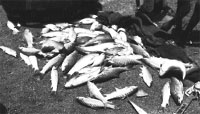Kheda: Forgotten glory
 With great vigour, the mrc took up the first bioenvironmental programme in 1983 in the Nadiad taluka in district Kheda, central Gujarat. For five years, its staff toiled relentlessly in this area to eliminate breeding sources without the use of chemicals. The project ended in 1989. "We wound up in 1989 because this icmr project did not receive extension,' says R S Yadav, station in-charge, mrc , Kheda. Subsequently, the state government has been following orders from the nmep and has made no effort to continue the good work. Kheda has moved back to the pesticide regime. A P Pandya, regional director, nmep , Ahmedabad, confirms: "In the absence of bioenvironmental management strategies, the areas were brought back under the pesticide regime'.
With great vigour, the mrc took up the first bioenvironmental programme in 1983 in the Nadiad taluka in district Kheda, central Gujarat. For five years, its staff toiled relentlessly in this area to eliminate breeding sources without the use of chemicals. The project ended in 1989. "We wound up in 1989 because this icmr project did not receive extension,' says R S Yadav, station in-charge, mrc , Kheda. Subsequently, the state government has been following orders from the nmep and has made no effort to continue the good work. Kheda has moved back to the pesticide regime. A P Pandya, regional director, nmep , Ahmedabad, confirms: "In the absence of bioenvironmental management strategies, the areas were brought back under the pesticide regime'.
"Kheda is a potential site for the malaria epidemic because of the influence of factors that have resulted from ecological changes in the district,' adds Yadav. With the onset of canal irrigation, several factors such as continuous irrigation, multiple cropping patterns, increased waterlogging due to seepage from canals and the lack of proper and adequate drainage have resulted in the alarming rise in the incidence of malaria.
In the early 1980s, district Kheda had a very high incidence of malaria. The annual parasite index ( api , which is derived by dividing the number of malaria cases by the population) shot up to 28 in 1981, about seven times higher than the corresponding national average of 4.1. The problem of mosquito resistance had become a matter of great concern as chemicals had been indiscriminately sprayed over the past years.
In Nadiad, one of the ten sub-divisions of district Kheda, the incidence of malaria before 1983 had been consistently the highest compared to the rest of the district. "A massive outbreak of the disease in Bamroli, one of the 100 villages of the Nadiad sub-division, occurred in 1981. The disease was in epidemic proportion, killing over 100 people and affecting a few thousands,' recalls Yadav.
The project was initiated in seven villages. In May 1985, it was enlarged to cover the entire Nadiad taluka. From 1983 to 1989, an intervention team comprising of experts in entomology, supporting staff, daily-wage workers and voluntary labourers under the technical guidance of the mrc took up activities such as filling and levelling of low-lying areas with earth, drainage of water collection from smaller water bodies and construction of soakage pits for structured drainage. Open intra-domestic containers were covered and fishes introduced in village ponds. Health camps and exhibitions were organised and women and children were mobilised. "The chain of sustained activities greatly helped in generating confidence among the people,' believes Yadav.
S Haq, mrc 's expert on fisheries, helped to create fish hatcheries in village ponds. Within a few years, 94 hatcheries were established and maintained by mrc staff with the aim of having a hatchery in every village so that fish could be made available easily to villagers.
Edible and larvivorous fishes were farmed in eight ponds that were otherwise infested with water hyacinth. This not only helped to control mosquito breeding but even improved the village economy as the money generated went to the village panchayats, which, in turn, spent it on development activities such as laying down underground drainage. Four of the eight ponds yielded about 10 tonnes of fish worth about Rs 100,000.
Incidence of malaria in the project areas was consistently lower than in areas where spraying of chemicals continued. "The difference shown is an underestimation. This would have been more pronounced if the frequency of surveillance was the same in the non-project areas,' comments R M Bhatt, entomologist with mrc , Kheda. According to Bhatt, the non-project areas were under fortnightly surveillance under the nmep , as compared to weekly surveillance in the project areas under the mrc . As the malaria parasite has a 10-12-day cycle in the host, the parasite may not have been detected in the fortnightly surveillance.
In 1989, the project on alternative vector control was ended in Nadiad. The mrc exhausted its research grant. Lots of people including daily-wage workers and surveillance workers lost their jobs.
A visit to Kheda now reveals a shocking scenario. Villages have reverted to the pre-project stage. No efforts are being made to reduce breeding sources. There is no attempt to carry forward the work done by the mrc . Hatcheries reveal blooms of water hyacinth. nmep 's data shows that alarming levels of ddt were being used in Kheda after the mrc projects were phased out.
